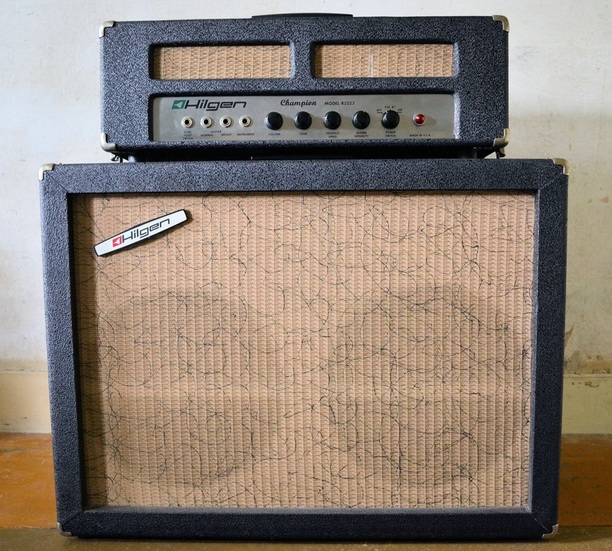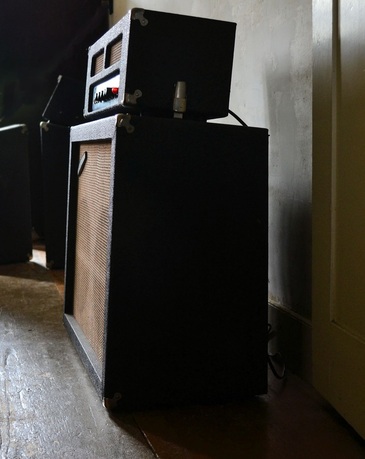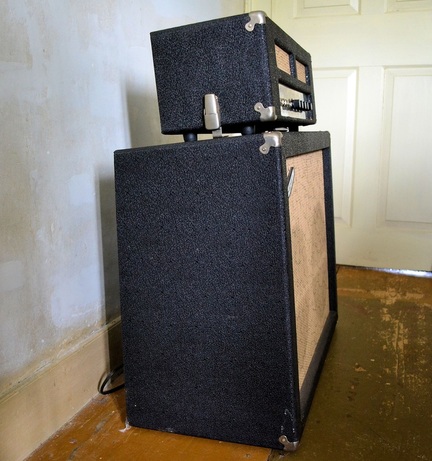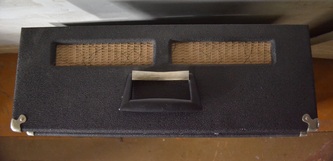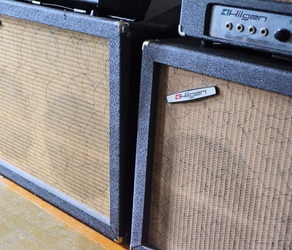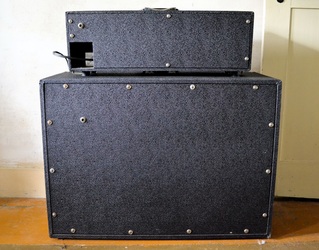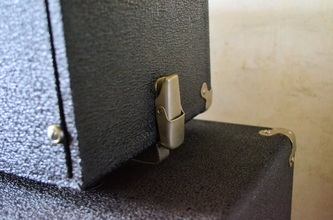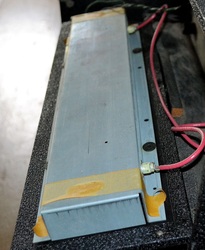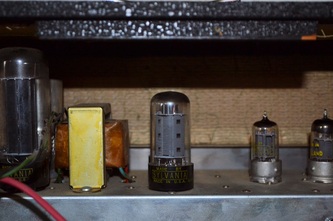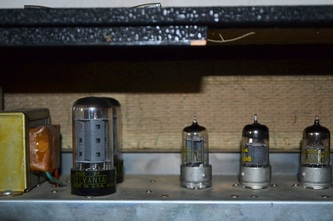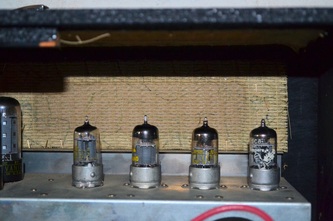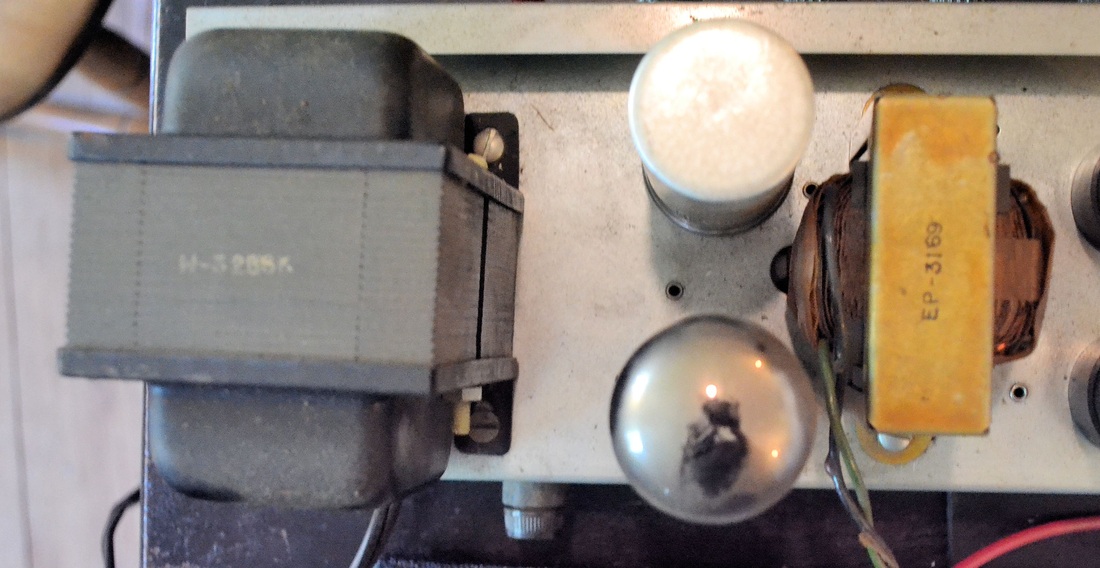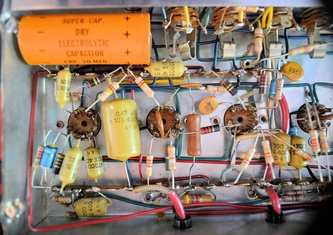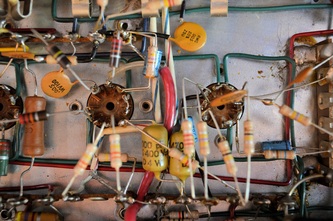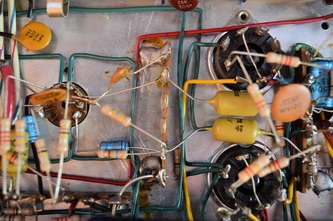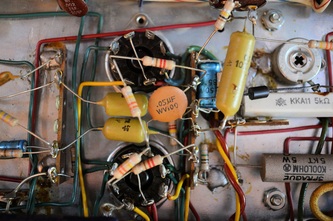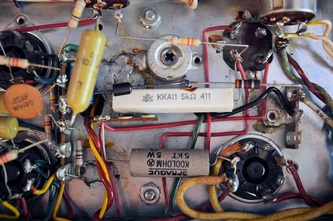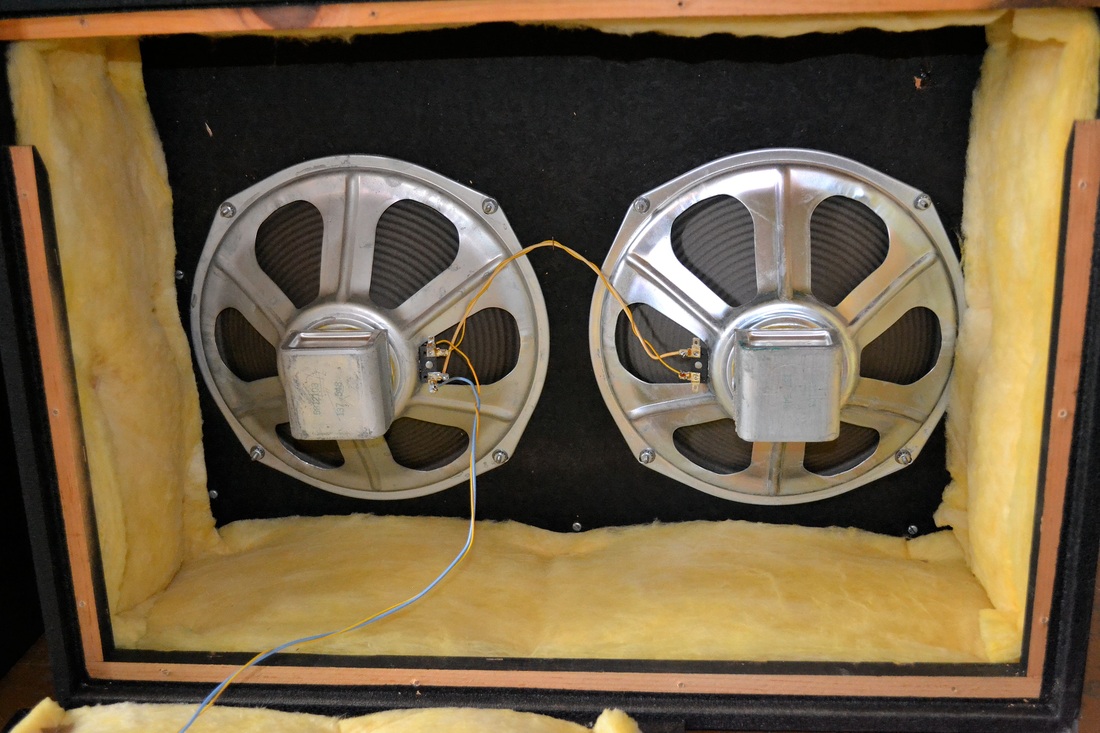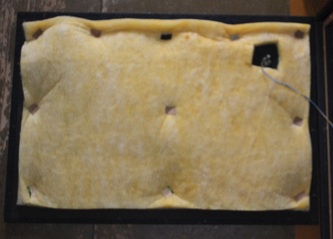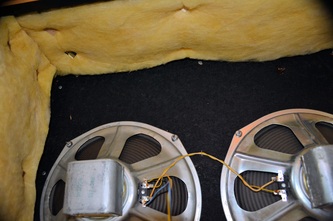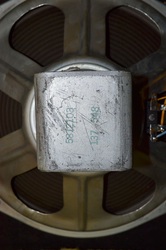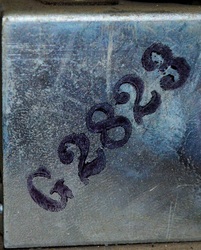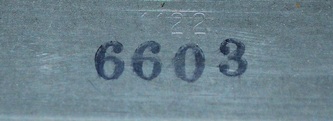MODEL 2523: the "champion"
Upper Chassis

The second 7591 power tube is behind the first. Behind the rectifier tube is the filter capacitor can.
transformers
Lower chassis
 Chassis wiring and circuit layout. Note the addition of a bias pot, a feature not found on earlier and less sophisticated Hilgen circuits. Creative use of multiple terminal strips to facilitate point-to-point connections without crowding.
Chassis wiring and circuit layout. Note the addition of a bias pot, a feature not found on earlier and less sophisticated Hilgen circuits. Creative use of multiple terminal strips to facilitate point-to-point connections without crowding.
Speaker cabinet
NUMERICAL CODES
The Model R2523 Champion was Hilgen's only piggy-back guitar amp besides the Model 5063 Swing Away. The head could be temporarily attached to the cabinet with snap latches. The cabinet was designed with a slanted front so as to direct sound from the speakers upward. The top of the cabinet slants downward from front to back, at a 90 degree angle to the speaker baffle, thereby rendering the control panel more easily accessible to the player. The cabinet top also has four rubberized recesses to receive the rubber feet on the bottom of the head, enhancing stability. Attached to the rear panel of the head is a full-size Hammond/Gibbs reverb tank, connected to the chassis by standard RCA-type jacks.
Although far simpler in design than the Model 5063 Swing Away Guitarist, the Model R2523 Champion is an exemplary lead guitar amp. Because its power output is a little more than half that of the Model 5063 Swing Away Guitarist, the Model R2523 Champion breaks up at lower volumes. However, its distortion remains refined at all volumes, and is well-suited to producing a sweet, over-driven blues tone. The single tone control is surprisingly versatile; one does not miss separate bass, midrange, or "presence" controls. Although it has no depth control, the tremolo produces a fat, musical warble.
Date codes indicate that this amplifier was completed in 1966.
Although far simpler in design than the Model 5063 Swing Away Guitarist, the Model R2523 Champion is an exemplary lead guitar amp. Because its power output is a little more than half that of the Model 5063 Swing Away Guitarist, the Model R2523 Champion breaks up at lower volumes. However, its distortion remains refined at all volumes, and is well-suited to producing a sweet, over-driven blues tone. The single tone control is surprisingly versatile; one does not miss separate bass, midrange, or "presence" controls. Although it has no depth control, the tremolo produces a fat, musical warble.
Date codes indicate that this amplifier was completed in 1966.
Power
Approx. 28 Watts
|
Channels
Single
|
INPUTS
Dual Foot Switch
Guitar: Normal Guitar: Bright Instrument |
Control KNOBS
|
Dimensions and weight
Head:
Height: 7" Width: 21" Depth: 71/2" Weight: 16 lbs Cabinet Height: 20" Width: 27" Depth: 12" Weight: 30 lbs |
TUBE ARRAY AS FOUND
(right to left)
V1: Amperex Bugle Boy 12AX7/ECC83 (dual triode preamp tube) (original tube; both triodes tested well above "good" specs)
V2: Sylvania 7199 (triode/pentode reverb recovery tube) (original tube; triode tested above "good" specs, pentode tested below "good " specs)
V3: Unbranded, "Made in Holland" ECC82 (European version of 12 AU7) (dual triode preamp tube) (original tube; both triodes tested well above "good" specs)
V4: Sylvania 12AU7 (dual triode phase preamp tube) (original tube; both triodes tested well above "good" specs)
V5: Sylvania 7591A (beam-power-pentode power tube) (original tube; tested above "good" specs)
V6: Sylvania 7591A (beam-power-pentode power tube) (original tube; tested above "good" specs)
V7: Sylvania 5U4GE rectifier (original tube; tested "good")
All tests performed on calibrated Hickok Model 535A tube tester.
V2: Sylvania 7199 (triode/pentode reverb recovery tube) (original tube; triode tested above "good" specs, pentode tested below "good " specs)
V3: Unbranded, "Made in Holland" ECC82 (European version of 12 AU7) (dual triode preamp tube) (original tube; both triodes tested well above "good" specs)
V4: Sylvania 12AU7 (dual triode phase preamp tube) (original tube; both triodes tested well above "good" specs)
V5: Sylvania 7591A (beam-power-pentode power tube) (original tube; tested above "good" specs)
V6: Sylvania 7591A (beam-power-pentode power tube) (original tube; tested above "good" specs)
V7: Sylvania 5U4GE rectifier (original tube; tested "good")
All tests performed on calibrated Hickok Model 535A tube tester.
SPEAKERS AS FOUND
Two 12" CTS alnico speakers, clearly original
Identification and date codes
Chassis: G2823
Reverb: 6603
Speakers: 137548
Pots: 1376540
Pwr Tran: W-3286K
Otpt Tran: EP-3189
Reverb: 6603
Speakers: 137548
Pots: 1376540
Pwr Tran: W-3286K
Otpt Tran: EP-3189
